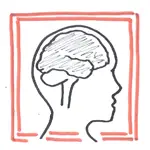Overview
Overview Dementia is a disorder that is characterized by impairment of cognition, typically involving memory and at least one other cognitive deficit, such as aphasia, apraxia, agnosia, or disturbance in executive functioning. These must represent a decline from previous level of function and be severe enough to interfere with daily function and independence. Decrease in intellectual function without an effect on the level of consciousness.
| Definition Dementia: Cognitive impairment typically caused by anatomic changes in the brain, has slower onset, and is generally irreversible. Dementia mainly affects memory. Delirium: Cognitive impairment typically caused by acute illness or drug toxicity (sometimes life threatening) and is often reversible. Delirium mainly affects attention. Agnosia: Failure to recognize or identify objects despite intact sensory function. Aphasia: Language impairment. Apraxia: Impaired ability to carry out motor activities despite intact motor function. Executive Functioning: Planning, organizing, sequencing, abstracting. |
Categories
Major dementia syndromes
- Alzheimer's Disease (50-70%) - 15% are familiar in origin including early-onset dementia
- Vascular Disease (10-20%) - Accumulation of small (lacunar) or large infarctions
- Lewy-Body Dementia (10%) - Clinically characterised by dementia and signs of Parkinson’s disease. Often inherited – mutations in alpha-synuclein and beta-synuclein
- Frontaltemporal Lobe Dementia
| Remember It is important to diagnose the type of dementia as treatment differs |
| AETIOLOGY | |
| Irreversible Causes | Reversible Causes |
| Alzheimer's disease | Hypothyroidism |
| Lewy body dementia | Depression |
| Huntington's disease | Vitamin B12 deficiency |
| Pick's disease | Normal pressure hydrocephalus |
| Cerebral infarct | Neurosyphilis |
| Creutzfeldt-Jakob disease | Chronic Alcohol use |
| Chronic substance abuse | Opiates |
Risk Factors
Cardiometabolic factors
- Atherosclerosis
- Diabetes mellitus
- Hypertension
- Hypercholestrolaemia
- Smoking
- Metabolic syndrome
- Obesity and BMI
- Vascular disease
- Atrial fibrillation
Other weaker factors
- Head trauma
- Alcohol
- Chronic kidney disease
- Homocysteine
- Dietary fat
- Oestrogens
- Hearing loss
- Gait impairment
- Vitamin D deficiency
- Inflammatory markers
- Medical illness
- Obstructive sleep apnoea
- Toxin exposure
- Medications
- Depression
Signs and Symptoms
Clinical Presentation A reasonably healthy elderly person who is experiencing an insidious onset of problems with memory and organizational ability, which worsened markedly over the past few months.
- Memory deficits
- Apraxia
- Aphasia
- Agnosia
- Loss of abstract thought
- Behavioural/personality changes
- Impaired judgement
- Loss of complex motor skills
Clinical Examination
- Signs of stroke?
- Signs of the reversible causes of dementia?
| Aetiology |
| Reversible Causes of Dementia |
| Hypothyroidism |
| Depression |
| Vitamin B12 deficiency |
| Normal pressure hydrocephalus |
| Neurosyphilis |
| Chronic Alcohol use |
| Opiates |
Differential Diagnosis
Differential Diagnosis (4D's of cognitive decline)
- Depression
- Delirium
- Decline (normal age related)
- Dementia
| Remember the reversible causes of dementia such as hypothyroidism, chronic alcohol use and vitamin B12 deficiency |
| Side note Both depression and dementia are relatively common and often coexist. Over 20% of people with an early degenerative dementia may be depressed or apathetic. This sometimes reflects a depressive reaction to the onset of dementia. |
| Definition Dementia: Cognitive impairment typically caused by anatomic changes in the brain, has slower onset, and is generally irreversible. Dementia mainly affects memory. Delirium: Cognitive impairment typically caused by acute illness or drug toxicity (sometimes life threatening) and is often reversible. Delirium mainly affects attention. |
| Difference between Dementia and Delirium | ||
| Dementia | Delirium | |
| Onset | Sub-acute | Acute |
| Conscious level | Normal | Fluctuates |
| Hallucinations | Late event | Common |
| Agitation/agression | Uncommon until late | Common |
| Thought form | Poverty of thought late | Flight of ideas |
| Memory | Slow decline | Poor |
Investigations
Cases of reversible dementia are uncommon, but their identification is important. Effective treatment may reverse the impairment and prevent its progression.
Assessment of Cognition
- Mini Mental State Examination
- Abbreviated Mental Test Score
- General Practitioner Assessment of Cognition
- Montreal Cognitive Assessment
- Addenbrook's Cognitive Examination
Bloods
- FBC - ↑MCV suggests alcoholism, or low B12 or folate
- ESR - Malignancy
- EUC, LFT - renal/hepatic failure, alcoholism
- BSL
- Thyroid Function test - hypothyroidism?
- VitB12
- ANA (antinuclear antibodies)
- STD screen (syphilis, HIV)
Other
- CXR - Sarcoidosis
- CT/MRI Brain – exclude treatable structural lesions (hydrocephalus, subdural haematoma)
- EEG - Creutzfeldt-Jakob disease
- CSF analysis - suspected infection, neurological diseases
- Urine bedside tests
- MCS
- Lumbar puncture - if CNS infection is suspected
- Electroencephalogram - if seizure activity is suspected
| Indications for Neuroimaging |
| Early onset (<65 years old) |
| Sudden onset or brisk decline |
| Focal CNS signs or symptoms |
| High risk of structural pathology (e.g., infarct, subdural hematoma, normal-pressure hydrocephalus, or tumor) |
Diagnosis
DSM-V Criteria of Dementia
Significant cognitive impairment in at least one of the following cognitive decline:
- Learning and memory
- Language
- Executive function
- Complex attention
- Perceptual-motor function
- Social cognition
With the following:
- Acquired and a significant decline from previous level of functioning.
- Deficits interfere with independence in ADLs.
- Disturbances aren’t occurring exclusively during course of delirium
- Disturbances aren’t accounted for by another mental disorder
Aetiology
| AETIOLOGY | |
| Irreversible Causes | Reversible Causes |
| Alzheimer's disease | Hypothyroidism |
| Lewy body dementia | Depression |
| Huntington's disease | Vitamin B12 deficiency |
| Pick's disease | Normal pressure hydrocephalus |
| Cerebral infarct | Neurosyphilis |
| Creutzfeldt-Jakob disease | Chronic Alcohol use |
| Chronic substance abuse | Opiates |
Pathophysiology
The pathophysiology section will focus on the most common irreversible causes of dementia:
- Alzheimer's Disease (50-70%)
- Vascular Disease (10-20%)
- Lewy-Body Dementia (10%)
- Frontaltemporal Lobe Dementia
Alzheimer’s Disease (50-70%) 15% are familial with two main groups
- Early-onset disease with autosomal dominant inheritance
- Later-onset (inheritance polygenic)
Pathogenesis
- Cortical atrophy
- Senile plaques and neurofibrillary tangles
- Accumulation of beta amyloid precursor proteins → progressive neurological damage
Vascular Dementia (10-20%) Accumulation of small (lacunar) or large infarctions
Pathogenesis
- Focal or diffuse infarcts or haemorrhage
- Small vessel disease; white matter ischaemia
| Side note One way of differentiating between Alzheimer's disease and vascular dementia is with a trial of cholinesterase inhibitors which is effective in Alzheimer's but much weaker in vascular. |
Lewy-Body Dementia (10%) Clinically characterised by dementia and signs of Parkinson’s disease. Often inherited – mutations in alpha-synuclein and beta-synuclein
Pathogenesis
- Accumulation or protein aggregates in neurons
- Lewy bodies in cerebral cortex – cytoplasmic inclusion bodies composed of ubiquitin and alpha-synuclein
Frontaltemporal Lobe Dementia (Pick's Disease)
Pathogenesis
- Atrophy of frontal/temporal lobes
- Agyrophilic cytoplasmic inclusion bodies of tau
Management
| Remember Involve the patient in her own therapy |
Non-Pharmacological Management
- Education for families and carers
- Encourage patients to maintain social, physical and recreational activities
- Brain stimulation and engagement therapy
Pharmacological Management
Treatment of Dementia
- Cholinesterase inhibitors – for Alzheimer’s disease only
- Loss of cholinergic neurones = ↓ acetylcholine levels
- Cholinesterase inhibitors act to prolong effects of acetylcholine
- Antiglutaminergic treatment
- NMDA antagonist = ↓ glutamate-induced neuronal degradation
| Pharmacology Cholinesterase Inhibitors or ChEIs (donepezil, rivastigmine and galantamine) work by inhibiting cholinesterase, an enzyme responsible for the break down of acetylcholine. ChEIs result in ↑acetylcholine molecules that are available to interact with the postsynaptic acetylcholine receptors, which results in an increase in central nervous system acetylcholine activity. ChEIs offer symptomatic benefit through stabilization of cognition (NOT A CURE). The underlying disease continues to progress at the same rate. Side effects: nausea, vomiting, diarrhea, anorexia, weight loss, dizziness, bradycardia, myalgias, and insomnia. |
| Side note In Alzheimer disease, atrophy of the nuclei in the cells in key areas of the brain, such as the basal forebrain, leads to a demonstrable decrease in cholinergic function. |
Treatment of behavioural and psychological symptoms
- Antidepressant with minimal anticholinergic side effects
Treatment of Agitation
- Antipsychotic medications (Caution with Lewy body dementia as it worsens Parkinsonism)
- Benzodiazepines
- Mood stabilisers – Sodium valproate
| Pharmacology The GABA-A receptor is a ligand-gated chloride-selective ion channel. The GABA molecule is inhibitory in nature and thus reduces the excitability of neurons. GABA produces a calming effect on the brain. Benzodiazepines also known as Benzo's, are GABA-A agonists. They work by binding to GABA-A receptors in the brain increasing the affinity of GABA and its receptor (benzodiazepines potentiate GABAergic neurotransmission). Side effects: drowsiness, lethargy, and fatigue. At higher dosages, impaired motor coordination, dizziness, vertigo, slurred speech, blurry vision, mood swings, and euphoria can occur, as well as hostile or erratic behavior in some instances. Tolerance, dependence, and withdrawal are adverse effects associated with long-term use |
Complications and Prognosis
Complications many with continuing management and abuse. This also encompasses problems towards the careers.
- Driving problems
- Falls risk
- Wandering
- Aggression - by a patient toward caregivers or family is usually verbal, but sometimes physical or sexual. It may lead to caregivers to refuse to work with a patient.
- Elder abuse may be difficult to identify, as the patient may not complain (due to fear or cognitive problems).
- Neglect of self-care is often with poor insight.
- Fire risk
- Financial abuse
- Medication administration
















